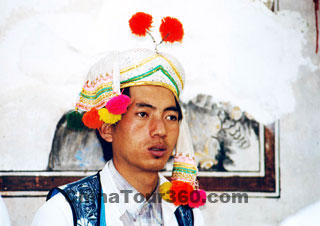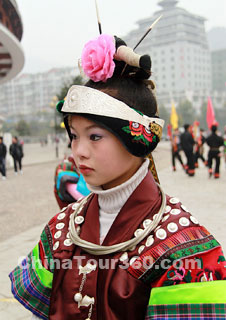China is a large country noted for its dense population and vast territory. There are 55 minority groups in addition to the Han who represent 92% of the population. The defining elements of an ethnic group are language, homeland, and social values. 53 minority groups use spoken languages of their own; 23 have their own written languages.
Equality, unity and common prosperity are the fundamental objectives of the government in handling the relations between minority groups. China exercises a policy of regional autonomy for various minority groups, allowing minority group people living in compact communities to establish self-government and direct their own affairs.
Achang ethnic group has a population of 33,936 (in 2000), gathering mainly in Longchuan, Lianghe, Luxi and Ruili counties in Dehong Dai-Jingpo Autonomous Prefecture in south-western Yunnan Province.
 |
| Bai People in Traditional Costume |
Bai ethnic group has a population of around 2 million, 90 percent of which live in the Bai Autonomous County west of Yunnan Province.
Blang people, with a population of about 91,882 (in 2000), live mainly in the Mt. Blang, Xiding, Bada and Daluo areas of Menghai County in Xishuangbanna Dai Autonomous Prefecture in south-western Yunnan Province.
Bonan ethnic group is one of China's smallest minority groups. With a population of about 16,000, they mainly cluster in the area around Mt. Jishishan and Linxia County, southwest of Gansu Province.
Bouyei (also Buyi) people, with a population of 2,971,460 (in 2000), are mainly scattered in the Bouyei and Miao autonomous prefectures in south Guizhou and Anshun.
Chaoxian people, with a population of nearly 2 million, is mainly living in Heilongjian, Jilin, and Liaoning Provinces.
Dai eithnic group, also known as Baiyi Eithnic Group, mostly lives in Yunnan Province. According to the statistic of 2006, there are totally 1.26 million Dai people in China.
Daur in their own language means "pioneer". The Daur people can be found in Inner Mongolia, Heilongjiang, and Xinjiang. The 2000 statistic shows that Daur population totals 132,394.
Deang nationality can be found only in Yunnan Province. Deang people are the descendants of Pu people.
Dong people mainly live in Guizhou, Hunan, and Guangxi. The population of Dong ethnic group totals 2,960,293 according to the 2000 statistics.
Dongxiang ethnic group, numbering about 380,000 in total, can be found mainly in Dongxiang Autonomous County of Gansu province with the remainder scattered in Qinghai, Ningxia and Xinjiang provinces.
Dulong (also known as Drung) ethnic group is one of the smallest minority groups in China. With a total population of about 5,816, the Dulongs mainly live in the Gongshan Dulong and Nu Autonomous County in north-western Yunnan Province.
Ewenki ethnic group has a population of 30,505 (in the year 2000) that is sparsely distributed across seven banners (counties) in the Inner Mongolia Autonomous Region and in Nahe County in Heilongjiang Province.
Gelao people refer to themselves as 'Ling' or 'Jin'. Their ancestors can be traced back to the Liao people who lived in Guizhou Province about 2000 years ago.
Hani ethnic group, with a population of 1,424,990, is one of the many unique tribes in Yunnan Province.
Hezhen people has a population of 4,640, and mainly live in the Tongjiang, Fuyuan and Raohe counties by the rivers of Songhua, Heilongjiang and Wusuli in China's northeastern Heilongjiang Province.
Hui people, with a total population of about 643,238 is one of China's largest ethnic groups. The largest residential area is the Ningxia Hui Autonomous Region.
Jingpo people has a population of about 132,000 (in 2000) people. They are concentrated in the Dehong Dai-Jingpo Autonomous Prefecture in Yunnan Province in southeastern China.
Jino ethnic group, with a total population of 20,899 (in 2000), resides primarily in Jinghong County of Xishuangbanna Dai Autonomous Prefecture in Yunnan Province.
Kazak, with a population of 1,250,458, is distributed mainly in the Xinjiang Ili Kazak autonomous prefecture, Mori and Barkol Kazak autonomous counties.
Kirgiz, with a total population of 160,823, is scattered throughout the southwest of the Xinjiang Autonomous Region.
Lahu trace their ancestry back to the ancient Qiang people, who immigrated to present day northern Yunnan from northwestern China early in the third century AD.
Li ethnic group, with a population of 1,247,814, mainly reside in Hainan Province, China's second largest island after Taiwan.
Lisu, with a population of 634,912, mainly live in concentrated communities in Nujiang Lisu Autonomous Prefecture in Yunnan Province.
 |
| A Girl of Miao Nationality |
Manchu, with a population of 10,682,263 (in 2000), are mainly distributed in Liaoning, Jilin and Heilongjiang provinces, of which Liaoning has the most Manchus.
Miao ethnic group has a population of 8,940,116, mainly scattered in Guizhou, Hunan, Yunnan, Sichuan, Guangxi, Hubei and Hainan provinces.
Mongolian, reputed as 'pearl in the grassland', have kept their nomadic living style for hundreds of years. 'Mongolian' originally was the name of one of the Mongolian tribes.
Naxi (also spelled Nakhi or Nahi) mainly live in concentrated communities in the Naxi Autonomous County of Lijing in Yunnan Province.
Nu is an ancient tribe that originally lived on the banks of the Nu and Lancang Rivers.
Oroqen is one of the ancient ethnic groups in north China. Oroqen, means 'people living on the mountain' or 'people using reindeer'.
Ozbek was named after Ozbek Khan, one of the local rulers under the Mongol Empire in the 14th century.
Pumi was used to be a nomadic tribe living in the southern part of Gansu Province and the eastern part of Qinghai Province.
Qiang ethnic group is one of the oldest tribes in China. They mostly inhabit hilly to mountainous areas of the Maowen County in the Aba Tibetan Qiang Autonomous Prefecture in western Sichuan Province.
Russian in China are the offspring of immigrants from Tsarist Russia. Many of their ancestors migrated to border cities in northwest of the country at the end of the 19th century.
Salar people's ancestors were the Samarkand people who migrated from central Asia to China during the Yuan Dynasty (1271 - 1368).
She nationality began to settle in the joint area of Fujian, Guangdong and Jiangxi provinces during the Tang Dynasty.
Tajik language belongs to the Iranian Austronesian, Indo-European languages Phylum. Most of the people in China speak the Sekule language whereas a few of them speak the Waihan language.
Tatar, historically named the 'Dadan', are descended from a branch of a Mongolian tribe, who used to inhabit the region near the Volga River.

Tibetan People
Tibetan is an old nationality in China who is mainly distributed in the Tibet Autonomous Region, Qinghai, Gansu, Sichuan and Yunnan provinces.
Tu call themselves 'Mongguer', 'Chahan Mongguer', and other names. There are different versions regarding the origin of the Tus, but most people believe that the Tus evolved from the Tuguhun people in ancient times.
Tujia people called themselves 'Bizika', which means 'native dwellers'. Although their name suggests that they are natives, their exact origin is still uncertain.
Uigur have lived at the foot of Mt. Tianshan for several centuries. They used to colonize in the north and northwest region of China before migrating to the Western Regions (present Xinjiang).
Wa people have a unique spoken language, which belongs to the Austroasiatic family.
Xibe people, originated from different geographical and historical backgrounds, are most distributed in the northeast and northwest and have developed vastly.
Yao ethnic group consists of hundreds of smaller subgroups. It is estimated that are about 300 Yao subgroups living in China, with differing traditional costumes and dialects.
Yi people can trace back to the Qiang people living in northwest China. They later migrated south and joined the local southwest aboriginal and created a new group.
Yugur originated from the Huihe people who were nomads around the Erhui River during the Tang Dynasty.
Zhuang people's ancestors were a branch of the ancient 'Baiyue' people, who lived in south China.







